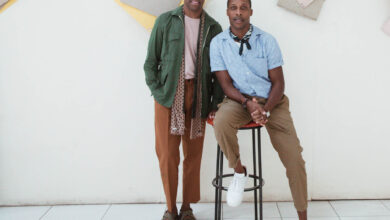How To Reduce Your Closet’s Carbon Footprint For Earth Month

Want to reduce your personal carbon footprint? We asked some experts how to navigate closet-related consumption in a manageable and meaningful way.
Reminders of the carbon footprints we create when we fly or drive are pretty much everywhere, from car charging stations to the offsets we can buy with our flights. But what about the damage done by our love of fashion?
“I had heard about carbon footprints for years, but I never thought they applied to clothing; I thought they only referred to things that you can actually see fuel come out of,” says Randa Salloum, a Vancouve-rbased entrepreneur who founded Collective Will, a second-hand shop and studio. “I want people to understand that improving their carbon footprint doesn’t just mean not buying fast fashion or buying slow fashion; it also involves thinking about where pieces of clothing come from, because they have to go through so many hands.”
It’s also important to think about what happens to your clothes over the years, adds Salloum. According to statistics provided by circular economy-focused organization Ellen MacArthur Foundation, less than 1 per cent of old clothes are recycled into new ones.
Dire-sounding data like this — plus the confusion perpetuated by greenwashing and the shame inherent in confronting our habits — can make change feel overwhelming. But sustainability-focused leaders have ideas that will help show you the way and maybe even uplift your journey.
Confront your consumption
Sustainability activists note that everyone’s carbon footprint and socioeconomic situation is different and therefore their approach to changing their footprint will be unique as well.
To get started, try using resale platform ThredUp’s Fashion Footprint Calculator. Through asking a series of questions, it can tell you what your habits equate to (in kilograms) in yearly emissions. Salloum says that the outcome can be jarring but is ultimately a good motivator. But before you make any drastic changes, you should not “set goals for yourself that are completely unattainable, like quitting fast fashion cold turkey,” advises writer and fashion consultant Aja Barber
Instead, she notes, “one of the things we can all do is just slow down.” Nurture the “less is more” mindset by buying fewer pieces (from sustainable labels or otherwise), re-examining your clothing budget, questioning the business practices of the brands you buy from and knowing your measurements before you make an online purchase (to avoid returns, a huge contributor to carbon footprint).
Take stock with an open and informed mind
Kelly Drennan, the founding executive director of Canadian organization Fashion Takes Action, says that a closet audit is pivotal to your carbon footprint reduction. Your audit should include three piles: keep, hold (“You may need to get a little creative” and alter or upcycle the items, she says) and donate. It’s important to highlight that there’s a dark side to clothing donation; items that North Americans cast off often end up in clothing markets in the Global South and in landfills to languish or be incinerated. Drennan recommends educating yourself about the operations of companies that take donations (learning whether they have the means to recycle pieces that can’t be resold, for example) as well as calling ahead to organizations such as shelters to find out what they’re in need of before donating a post-audit haul.
Make “handle with care” your mantra
Drennan notes that storing clothing properly after use, doing full loads of laundry with cold water, using water- and plastic-free detergents, tending to stains right away and avoiding dry cleaning are manageable moves that will extend the life and good looks of what you wear.
If you don’t know what to do with a damaged item, seek out mending resources like Lily Fulop. Her Instagram account @mindful_mending abounds with ideas for extending the life of your clothes and accessories. Or, take pieces to a nearby repair shop for a tune-up. In addition to tending to rips and holes, tailors and alterationists can tweak cuff and hem lengths as well as update the size and fit of a garment as your body changes.
“We need to view our garments as assets, not just consumables,” says Nina Van Volkinburg, co-founder and chief sustainability officer of upcycling platform Reture and a lecturer at the London College of Fashion in England. “My goal is very much to bring the idea of upcycling to a new audience.” Reture allows consumers from around the world to collaborate with a host of designers, including Canada’s Olivia Rubens, on updating wardrobe items. Not only does it mean you’ll get more wear out of what you already have but, as Van Volkinburg says, “it also gives power to the consumer.”
Recognize how and why you buy
Removing shopping apps, unsubscribing from brand newsletters and wiping your credit card information from automated fields can curb the immediacy of so-called retail therapy — a misnomer that implies that the serotonin kick we get from making a fashion purchase can quell deeper areas of unrest within ourselves. Drennan says that part of Fashion Takes Action’s programming includes youth education in an effort to instill better habits at a young age. It also helps people separate their wants from their needs — a crucial differentiator when it comes to what motivates us to buy.
Reduce, reuse and re-wear
Barber recommends that in addition to following social stars who re-wear their pieces proudly, such as Lydia Okello and Omar Ahmed, you should “look at designers.” She name-checks the likes of Phoebe Philo and Tom Ford (“The people who bring you beautiful designs every season generally have a uniform that they don’t deviate from much”) and adds that while you are developing your own mindful fashion statement, using Pinterest as a place to put your product wish list is a good practice, as is working with a personal stylist who can maximize the potential of your pieces.
This article first appeared in FASHION’s April issue. Find out more here.





